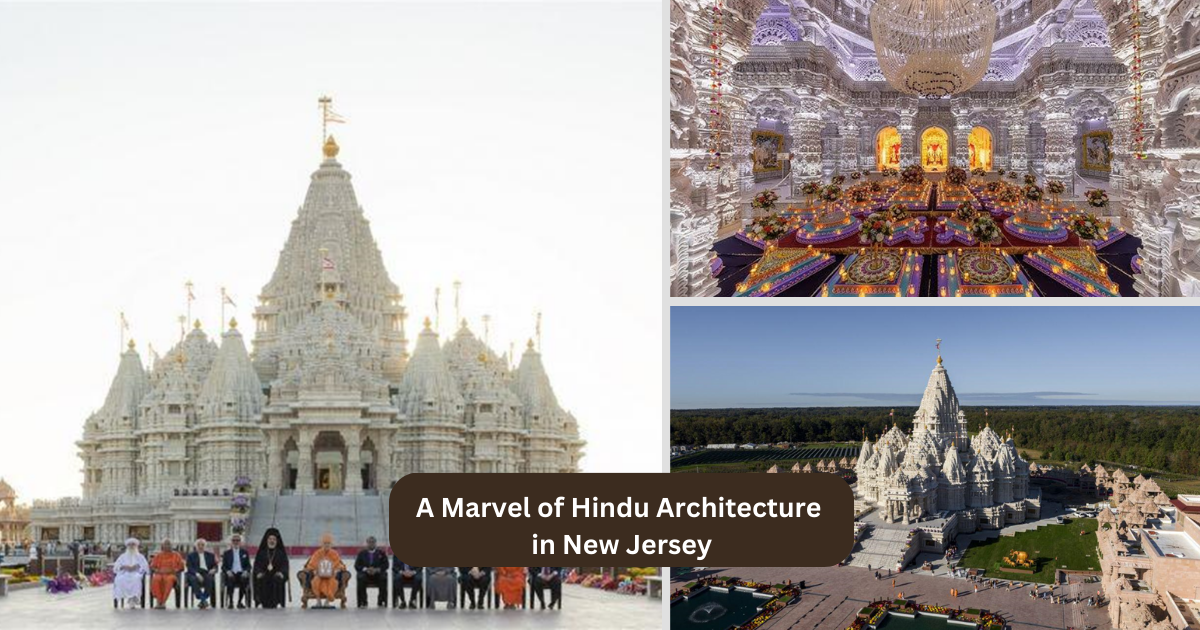The Akshardham Temple in Robbinsville, New Jersey, is a magnificent Hindu temple complex that showcases the rich culture, heritage, and faith of the Swaminarayan sect, a branch of Hinduism. The temple, inaugurated on October 8th, 2023, is the world’s second-largest Hindu temple and the largest outside of Asia. Dhanush Kumar looks at the architectural masterpiece and its cultural significance.

A Work of Devotion and Artistry
The construction of the Akshardham Temple was a colossal undertaking, requiring a harmonious blending of engineering, artistry, and unwavering devotion. Skilled artisans and volunteers invested around 4.7 million hours of labour to hand-carve approximately two million cubic feet of stone. Imported marble from Italy and limestone from Bulgaria traveled over 8,000 miles to New Jersey, where they were meticulously pieced together like a colossal puzzle, forming a breathtaking 191-foot high structure.

The temple also incorporates Vastu Shastra and Pancharatra Shastra, ancient sciences that align the natural and spiritual energies within the building.
Deities and Worship
The heart of the Akshardham Temple lies in its shrines, dedicated to various deities and gurus of the Swaminarayan sect. The central shrine houses the murtis of Swaminarayan and Gunatitanand Swami, revered as Akshar-Purushottam Maharaj. Swaminarayan is considered God’s supreme manifestation by his followers, while Gunatitanand Swami is regarded as his ideal devotee and spiritual successor.

Other shrines host murtis of Radha and Krishna, Shiva and Parvati, Sita and Ram, Hanuman, Ganapati, and the lineage of BAPS gurus, who are Swaminarayan’s spiritual successors.
Cultural and Educational Activities
The temple complex extends beyond its spiritual core, housing a cultural center, a multimedia theater, and a heritage museum offering a rich tapestry of visitor experiences. The cultural center hosts festivals, concerts, seminars, workshops, and classes celebrating and promoting Hindu culture and values.

The multimedia theatre screens films depicting the life and teachings of Swaminarayan and his gurus. The heritage museum showcases exhibits highlighting Hinduism and BAPS’s history, traditions, and contributions.
Enriching Visit
The Akshardham Temple welcomes visitors and worshippers daily. Visitors are encouraged to respect specific rules, such as removing shoes before the temple premises, dressing modestly, refraining from photography, and maintaining a solemn atmosphere in the sanctum areas.

Visiting this awe-inspiring temple is a truly enriching experience, offering a glimpse into the diversity and beauty of Hinduism and its universal message of love, service, and devotion. It also provides an opportunity to learn about the Swaminarayan sect and its spiritual leader.
Conclusion
Akshardham Temple in New Jersey is a marvel of Hindu architecture and spirituality, beckoning everyone to experience its splendor. It embodies the faith and dedication of the Swaminarayan sect, as well as its vision of creating a better world through spirituality and service.





























